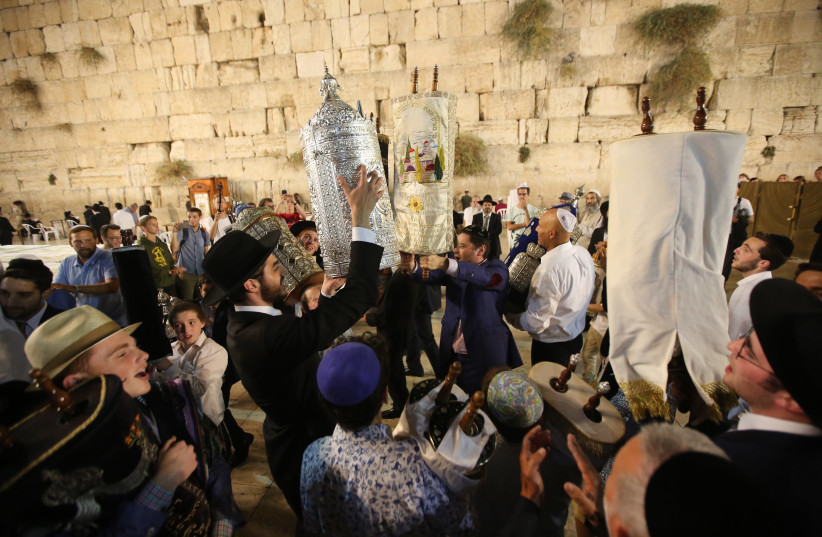Unlike other festivals, Simhat Torah has no roots in the Torah other than the Midrashic interpretation of morashah kehillat Yaakov (an inheritance of the congregation of Jacob) (Deut. 23:4), which the sages suggested could be read as me’orasah (betrothed), indicating that the Torah and the Jewish people have an age-old love affair. There is also a series of marriage metaphors that link God and Israel in a union that (in Sephardi custom) begins on Shavuot; God is the groom and Israel is the bride who sometimes, as in the Book of Hosea, strays from God.
The historian Cecil Roth had a theory that Simhat Torah was modeled on a wedding. Writing in the London Jewish Chronicle nearly a century ago, Roth derived from Jewish marriage customs the Simhat Torah practices we are used to. The bride and groom are royalty for a day. They are extolled by means of hymns in their honor, they are garlanded and showered with sweets and cakes, and their joy is shared by the community.
The Simhat Torah groom is the Hatan Torah or Hatan Bereshit, chosen for his dedication to the community. The bride is the Torah, betrothed to Israel with God looking on benignly and in joy. The day is rendered complete by a lavish Kiddush. The children are given bags of treats. When I was a child, we youngsters would form a line around the perimeter of the shul to get a chocolate bar. Being cheeky, I kept coming back for more and saying, very politely, “Please can I have one for my little brother?”
Over the ages, it is the male gender who have appropriated Simhat Torah as their celebration, though in recent years, there have been attempts to give the women an active share. In some places there are women’s circuits with the Torah, women’s dancing and women’s Bible study leading up to a siyum (conclusion) on Simhat Torah.
The customary seven circuits, like the Ushpizin on the seven evenings of Sukkot, are said to honor our Biblical ancestors, Abraham (the symbol of spiritual pioneering), Isaac (who represents stability), Jacob (community), Joseph (courage), Moses (prophecy), Aaron (harmony) and David (emotion). The lists of Biblical icons differ but they all pay honor to the principles and precedents that our ancestors brought to Judaism. Perhaps the circuits echo our ascent to God through the seven heavens. Maybe they recall the circuits around Jericho.

There are communities where the Simhat Torah jollification has tended to get out of control, with overmuch vodka and plenty of verve. Whisky and herring have become par for the course. When the writer Samuel Pepys visited a synagogue in London in 1663 soon after the Jewish resettlement in England, he was dismayed at the exuberance of the congregation and he called it religion absurdly performed. What the Jews were up to he did not explain in detail but if he came to shul on Simhat Torah these days he might be even more shocked than in the 17th century.
The celebrations today
The critics 300 years later are mostly Jewish. When I was finding my way in the British rabbinate, I introduced dancing on Simhat Torah at the Hampstead Synagogue, to the immense displeasure of some of the congregation. I was confronted by one of the members folding his tallit and announcing, “My grandfather would turn in his grave.” I never knew his grandfather but I suspect the old man might have enjoyed a “Knees up Mother Brown.”
Nonetheless, I recall that the humorist Chaim Bermant poured scorn on Simhat Torah and compared it to a lying-in-state. In those days the stately cathedral synagogues could not let their hair down (that is, if they had any hair left) and kept the occasion under decorous control. Most synagogues these days, however, relax the rules of decorum on Simhat Torah and allow the celebration to spill out onto the street.
Simhat Torah usually comprises an evening and morning of jollity. Some congregations have a Torah reading in the evening as well as the morning, though normally the Torah is only read in the morning. The Tur (Rabbi Jacob ben Asher) explains that when we end the Torah we straightaway recommence it to show Satan that the people of Israel never come to the end of their love of the Torah.
On the morning of the festival, large numbers of men are called to the Torah reading and a special call-up is reserved for the children, who are then given the blessing which Jacob bestowed upon his grandchildren (Gen. 48:16).
The occasion has long been an annual affair, though in ancient times the reading in Eretz Israel followed a triennial cycle, whereas in Babylon the custom was to take one year to finish the Torah reading and presumably to add a culminating celebration of some kind at the end of the festive period. In the Middle Ages, the second day of Shemini Atzeret was given a name of its own (Simhat Torah) and endowed with its own character.
One of the calendrical puzzles is the question of why we don’t celebrate Simhat Torah several months earlier on Shavuot when the Torah was given to Israel at Mount Sinai. The Dubner Maggid explains that when the Torah was given, the people of Israel were uncertain of the marriage and it took several months to become absolutely sure that the love of the Torah was deep and lasting.
The writer is emeritus rabbi of the Great Synagogue, Sydney.
